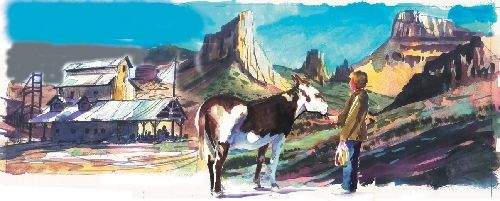Old West, storied Route 66 converge in Oatman, Ariz.

Sitting astride Historic Route 66, Oatman, Ariz., returns to its glory days when classic cars roll into town. Vehicles like these commonly passed through the former mining boomtown when U.S. Highway 66 was the preferred route from Chicago to the Pacific Coast.
The travelers kept Oatman on the map after the early mining years ended. But when a new highway rerouted the passing cars and trucks, Oatman nearly died.
Two unrelated developments saved the old town after decades of decline.
First came the burgeoning growth of Laughlin and Bullhead City, Ariz., across the Colorado River from each other and just a 30-minute drive from Oatman. Although the old town attracts tourists year-round, most arrive on weekends and holidays. Visitors to the riverside resorts, casinos and regional recreational attractions can’t seem to get enough of Oatman’s Old West flavor and engaging “wild” burros.
Second was the unexpected popularity of Route 66 as a rolling destination, a nostalgia drive that draws visitors from around the world. The longest intact section of the old 2,500-mile route runs right through Oatman. That 150-mile segment is actively promoted by the Arizona Historic Route 66 Association.
On May 4, Oatman hosts nostalgia seekers participating in the 25th annual Route 66 Fun Run in northwestern Arizona, retracing the old highway from Ash Fork to Topock on the river. During Fun Run weekend, Oatman regains the excitement of her boom years, brimming with visitors and vintage cars, and contends for the title of liveliest ghost town in America.
Visitors from Las Vegas reach the Laughlin-Bullhead City area by following U.S. Highway 95 south to Nevada Route 163, a drive of about 90 miles. Two routes access Oatman from Bullhead City — one paved and longer; the other partially paved, rough and shorter at about 25 miles.
On the paved route, follow Arizona Route 95 south through Bullhead City about 20 miles to Boundary Cone Road. Turn left and head east about 20 miles to Historic Route 66. Then turn left and drive north a few miles to Oatman.
Less than a mile south of town, watch for Oatman Stables, where visitors can take guided horseback trail rides or tour in a vintage stagecoach. Horseback rides cost $25 per person for a half-hour ride, $35 for an hour or $60 for two hours. Fares for stagecoach rides are $25 for adults and $15 for children 10 and younger. Visitors to the stables can also pan for gold; a 2½-hour adventure costs $110 per person. For reservations, call (928) 788-1764.
On the unpaved route to Oatman, turn on Silver Creek Road at a major stoplight in Bullhead City and follow the pavement past a city disposal site. From there, a scenic gravel road follows a wash toward the dramatically formed Black Mountains. A few small active mines lie near this road in the hills around Oatman.
Oatman began as a tent town after gold discoveries in the early 1900s. The town was at first called Vivian after an early mine, but its name was changed to Oatman in 1909 for Olive Ann Oatman, an Illinois child captured by Yavapai in a massacre of most of her family in the early 1850s. After a few years as a captive, she was traded to the Mohave people, who tattooed her face in the manner of their culture. She was returned to her surviving brother in 1857 near the future site of the mining town.
Look for photos of Olive Oatman in the two-story Oatman Hotel, which was built in 1902 and is the oldest adobe structure in Mohave County, Ariz. Following major gold strikes in 1915, the town boomed, growing from a few hundred residents to 3,500 in a year. Most of the buildings constructed during the boom burned down in 1921, but the adobe hotel survived. The major mine closed in 1924, but others remained in operation until a government-mandated shutdown in 1941.
At that time, a few burros used by miners were turned loose to fend for themselves, forebears of the burros welcomed today in Oatman. Fed carrots and horse pellets by visitors, the burros and their springtime foals enjoy the run of the town with its shops and eateries on Historic Route 66. They don’t seem to mind the noisy staged gunfights that erupt on the main street twice a day.
Margo Bartlett Pesek’s Trip of the Week column appears on Sundays.